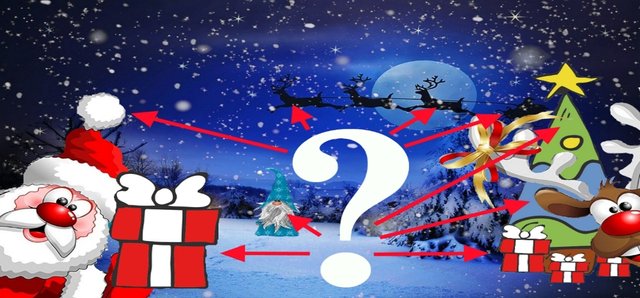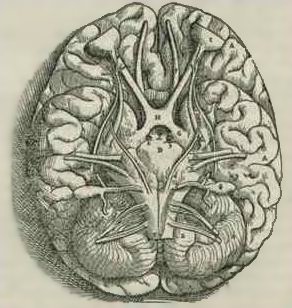Myths vs Reality. #2 Christmas. Introduction

(the overall image was created by me by combining the images from Pixabay, namely: Flying reindeers, Santa and a reindeer, An Elf, Christmas attributes)
The Brain — is wider than the Sky —
For — put them side by side —
The one the other will contain
With ease — and You — beside —
The Brain is deeper than the sea —
For — hold them — Blue to Blue —
The one the other will absorb —
As Sponges — Buckets — do —
(‘The Brain is wider than the Sky’ poem by Emily Dickinson)
You might be surprised to see that piece of a poem in the post titled like that (“Myths vs Reality. Christmas. Introduction”). A lot will start making sense soon.
Disclaimer (important)
If you’re a child (or Phoebe Buffay), the information given in the posts of this series can ruin/break your expectations regarding Christmas.
I will not have any responsibility for the consequences.
On the other hand...
Jacque Fresco (the one who believes that it’s our environment which determined the way we behave) mentioned a lot of times that the kind of a child you get depends on the environment you “feed” him/her with.
The childrens' capabilities are usually underestimated.
That’s why there’s “Biochemistry Literacy for Kids” project.
”Unlocking the true potential of young learners:
"Biochemistry Literacy for Kids revolutionizes STEM learning by making college-level science accessible to K-12 students. Developed by Yale-educated chemistry professors, our curriculum creates a unique visual and tactile learning environment that makes high-level chemistry and biochemistry fun and rewarding for kids as young as age 6."
(source)
Prologue
In this post I’d like to talk about Christmas, well-known religious holiday celebrated by billions of people all over the world.
Christians number 2.2 billion, or about one-in-three (32%) people worldwide.
((source) - [1])
While being the major Christian holiday, Christmas is a tradition not only for religious people, but for non-religious people as well [2].
The latter consider it as a chance to spend more time with their family, exchange gifts, dance and have fun. For children it is usually associated with Santa Claus coming into the house through chimneys with gifts, flying reindeers etc.
I’d like to try to answer 2 main questions:
Where does the tradition/holiday originate?
Why have/How could we ended up in such a situation (having flying reindeers and Santa Claus…)?
While the answer to the 1st question could be illustrated with the help of just 1 image, answering the 2nd question will take a lot of writing. It’s because the answer should lie within our brain (its properties/features/capabilities), that “device” we all have.

World views
There’s a number of so-called world views/world outlooks, namely (at least):
- mythological (think of Greek mythology)
- religious (think of Christianity, Buddha etc.)
- scientific
world view
is the way they see and understand the world, especially regarding issues such as politics, philosophy, and religion.
(Collins Cobuild Advanced Learner’s English Dictionary. New Digital Edition, 2008)
That world view depends on the environment we grown up.
People had very different world view several thousands years ago from what we have today.
Mythological, religious and scientific world views try to explain our world.
They try to explain what reality looks like. And they define how people will behave in different situation.
I’ve tried to explain why it’s hard to see the way thing are in the first post of this series.
The scientific view of the world seems to me the most realistic one, because it’s based on experiments.
a scientific procedure undertaken to make a discovery, test a hypothesis, or demonstrate a known fact
(Oxford Dictionary of English, 3rd Edition, 2010)
But if you tell these kids that you have a special power, they don't work on problems.
See, if you prey and hope that it rains…
You have to dig an irrigation system to save you out of drought and help the plants to grow.
(Jacque Fresco. “Charlie Veitch interviews Jacque Fresco in London”)
Technology and Science is not the answer to all our problems.
But it has more answer than non-technology/non-science.
In fact, there’re so-called scientific revolutions (think of Copernican Revolution for example).
In a nutshell, at some point there’s quite a few anomalies in the current scientific paradigm.
This leads to new paradigm (paradigm shift, as per Thomas S. Kuhn's “The Structure of Scientific Revolutions” (1962)), the one which can explain those anomalies.
The theory
In this series of posts I’ll share the theory (which try to provide scientific explanation for Christmas-related events) which was told to me at the university I was a student of.
Please, note that it is just a theory. There’s no 100% guarantee it’s the truth. As I said in the Intro post of this series, it is really hard nowadays to figure out what the truth is because of a huge amount of misinformation.
Once I’ve heard the explanation (which is quite funny), suddenly everything about Christmas just started make sense. I believe at this stage of my life that there’s way too much coincidence between that theory and Christmas which are not accidental.
What's the plan?
I want to share the plan for this series.
To try to answer the above 2 questions, we’ll need to talk about metaphors, allegories, abstractions in the 1st post.
Then, in the 2nd post, we’ll talk about the thinking process itself trying to figure out how it even happens (does it happen with the help of images, language, or what?).
Then we’ll discuss the actual theory which tries to explain Christmas-related stuff.
After that I’d like to talk about biochemical foundation supporting the theory.
And, finally, I’d like to talk about the impact that Christmas has on our environment.
Metaphors, allegories etc.
An important role in this series will be played by metaphors.
metaphor
A metaphor is an imaginative way of describing something by referring to something else which is the same in a particular way. For example, if you want to say that someone is very shy and frightened of things, you might say that they are a mouse.
If one thing is a metaphor for another, it is intended or regarded as a symbol of it.
(Collins Cobuild Advanced Learner’s English Dictionary. New Digital Edition, 2008)
The Metaphor for this series and The first "kick"
As you, probably, noticed, the piece of the opening poem itself is metaphorical (the author tries to render some concrete aspects of the brain in concrete/visible/visual notions (sea, sponges, sky etc.)).
For the sake of having fun I’d like to try to create a metaphor for this series as well.
I’ll use “Inception” film for this.
In a nutshell, it’s about professional thieves who try to steal information by connecting with the target through a shared dream. There are several levels of the dream. And to get out of the dream, you need to get a so-called kick (you need to be in a free fall).
("Inception - What is a kick?" scene)
In the “Inception” there were 3 levels of the dream. Hence, the characters needed 3 kicks to wake up/come back to reality. The first one happened with the help of a car falling out of the track):
("Inception - Dream Layers Sync (In Realtime)", you can watch starting from 3:35 minute (top left))
To get more details about this film, I suggest you to read the article about it on Wikipedia or watch the film.
Just like characters of the film needed the kick to ultimately wake up, this series of posts is supposed to be (I hope) a kick for some people and help them to look at the Christams-related stuff from another point of view.
I think a lot of us at some point in our life believed that it’s Santa Claus who leaves you gifts under the trees.
Theoretically possible, that some adults still believe in that (is there anybody here???). Then, sorry, but let me give you the first “kick"...
("Joey and Phoebe's 'Deal with Santa' Explanation" scene)
Other posts of this series:
Myths vs. Reality. #1 Vampires, Werewolves… Is there any scientific explanation?
References:
All images (without the license specified + those from the film)/videos are used under the doctrine known in USA as "Fair Use" (similar doctrines are used in other countries). For more information visit the US Gov website